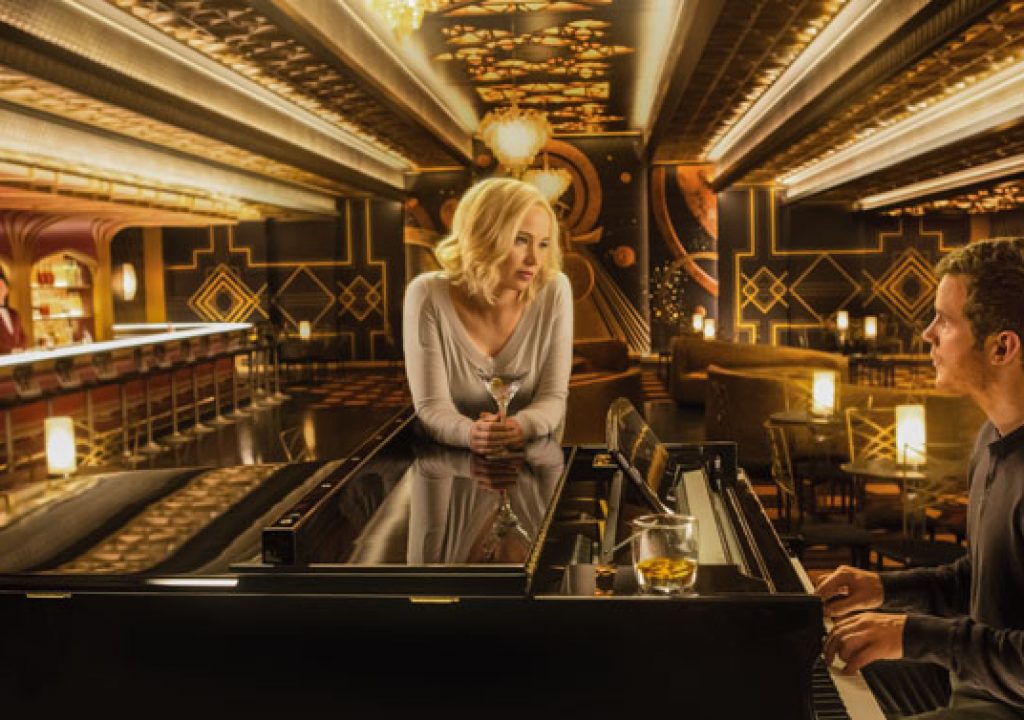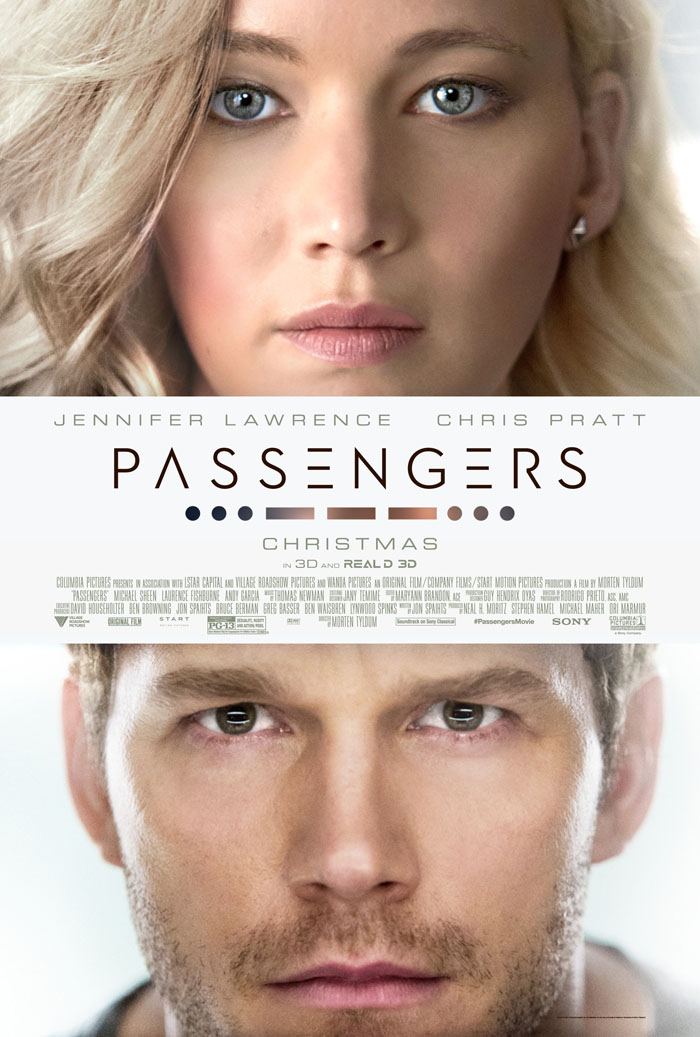 A year ago, Maryann Brandon was nominated for an Oscar for Best Editing for Star Wars: The Force Awakens. It was the latest film in a long-running collaboration with director and producer J.J. Abrams that goes back to the TV series Alias. Brandon’s credits include Star Trek Into Darkness, Super 8, and Mission Impossible 3. She joins Art of the Cut today to discuss Passengers.
A year ago, Maryann Brandon was nominated for an Oscar for Best Editing for Star Wars: The Force Awakens. It was the latest film in a long-running collaboration with director and producer J.J. Abrams that goes back to the TV series Alias. Brandon’s credits include Star Trek Into Darkness, Super 8, and Mission Impossible 3. She joins Art of the Cut today to discuss Passengers.
HULLFISH: One of the things I wanted to talk about was the macro-pacing of the movie and when do you try to hit certain reveals in the movie? Like, how long do you go before you realize that he is falling in love with Aurora and how long do you go then before he actually wakes her up? How long do you let him stew about it and worry about it? Was there a lot of messing around with deciding how long to have those bigger beats happen in the movie?
BRANDON: Oh yeah, for sure. There’s a lot of really good Chris Pratt alone stuff that I ended up just shortening because I just needed to get her in the movie quicker. It was all really great and it was all really fun. I got to say, both the director and I loathed to take it out because he’s so good, and it makes a lot of sense, it’s just that we realized that people knew she was coming and they were impatient to see her. So what I did was that montage of him being alone to the Elvis song. That was never written as a montage. That was scene – scene – scene – scene. He keeps going back to the bartender and ordering a new drink, ordering a new drink, ordering a new drink, and that whole thing built up until it ended with Arthur saying, “You’ve had every drink I can make.” And Chris goes, “I’ve had them all?” The individual scenes all played well, but it just felt in the aggregate it was too much.
HULLFISH: That’s one of those interesting things, right? You cut these scenes together that work in and of themselves, but combined, it’s too much.
BRANDON: There’s a whole scene where he learns to speak Russian and Chinese. It’s not long, it’s just he starts and then he speaks Russian to Arthur and then he speaks Chinese to Arthur. It’s one of those things when you make the point so many different ways, and you only need to make the point once.
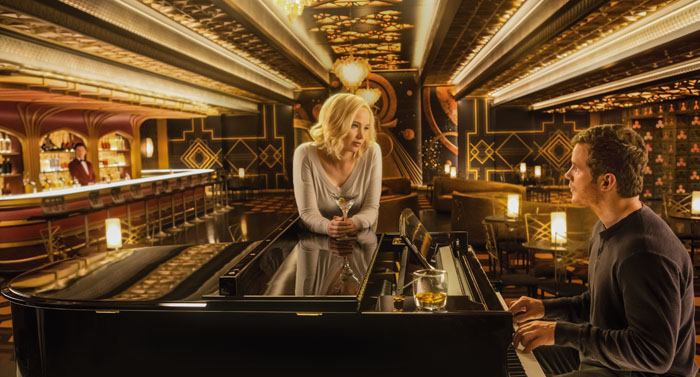
HULLFISH: And like you said, you’re trying to get to Aurora waking up.
BRANDON: You really have to, because first of all it’s Jennifer Lawrence. There’s also the element that you know she’s coming.
HULLFISH: She’s in the poster and you’ve seen her in the trailer, so…
BRANDON: Right. And so you know she’s coming. And you don’t want to not have her in there soon enough. Also, you just need to move the story along. If it were an indie film perhaps, maybe it would be a nice interesting character study. But it’s not. And so there was just this feeling all of us had when we watched it that it couldn’t sustain more than–I think she comes in twenty minutes into the film. And the studio was really, like, “We have to get her in earlier.” And I think it works.
HULLFISH: After a while the audience is just thinking, “Where’s Jennifer Lawrence? Let’s get her out here.”
BRANDON: Exactly.
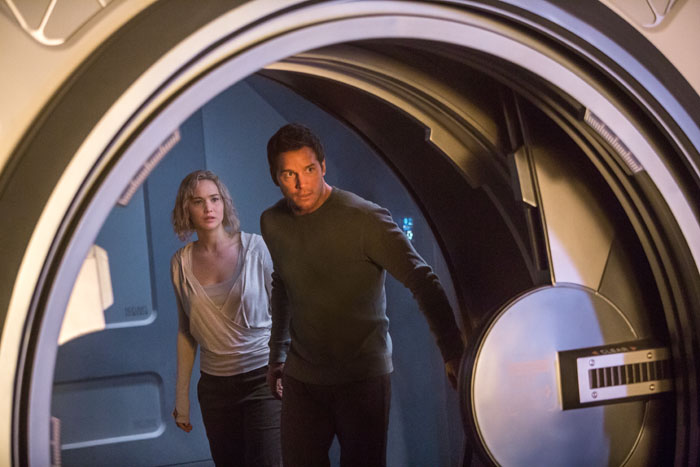
HULLFISH: I want to stay with this story beat idea because I think it’s really fascinating to get your sense and the director’s sense and the studio’s sense of when stuff has to happens, because then of course -to me at least – the next big reveal is “When does Jennifer find out that he woke her up intentionally?”
BRANDON: It was the same deal. You have to feel your way through. Just when you feel the audience drifting, you want to pull back with some other big reveal. And I think that was in the script, that sort of period of them falling in love. Obviously I edited it down. It’s always the case that you cut down from what was shot, but it’s pretty much all there. I’d say the very middle of the film is where she finds out. I’d say it happens smack in the middle right at the beginning of reel five.
HULLFISH: How many reels were in the movie?
BRANDON: There were eight, but that includes credits and all that, so it’s really seven and a half. The picture, without credits… I think it’s an hour forty-eight.
HULLFISH: Is there a complication in editing only dealing with a single character and then also just having such a small cast or was that a blessing?
BRANDON: Oh my god, it’s incredibly hard to have such a small cast. The studio kept saying to me, “It’s a really easy film.” It’s just four people, and mostly just two people and a kiss and I was like no, that makes it really, really hard. That means every shot, every moment, counts. There’s no fluff. And when you do go into something like a space walk or something less dialogue driven or driving the story forward, you have to be really careful because there’s not a lot of characters. It’s kind of like Gravity where you were just with Sandra Bullock the whole time and that’s it. That’s what you get: somebody’s outer and inner thoughts. And I think it makes it really hard.
HULLFISH: That’s the reason I asked the question: because I figured that it was difficult.
BRANDON: Yeah. A battle scene is easy, for me anyway. You just track what’s happening in the battle and you can cut to anything.
HULLFISH: Since we’re talking about the difficulties of a single character, one of the scenes that I can think of that would have been much easier with a larger cast or at least one other person is–and I don’t want to reveal anything–but he goes out on a space walk and then he kind of almost makes a very critical decision and there’s no one there to kind of discuss that with. You don’t get to hear how he feels or know what he was thinking. You have to infer that from the images you cut together instead of from dialogue.
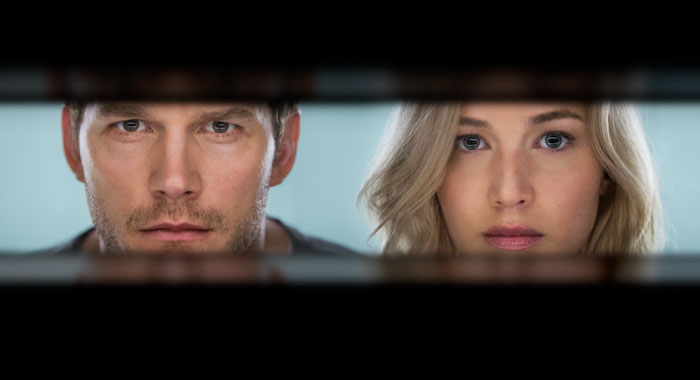
BRANDON: Yes.That’s all performance-based and directorial-based, and I only take what I’m given and try and make the most of it with sound and music and picture. It’s all about how the director realized it and then what he gave me to deal with to give you those ideas.
HULLFISH: Another space movie that’s similar is The Martian, right? You’ve got one guy on a planet by himself. How does the audience know what he’s thinking and feeling?
BRANDON: Right. Exactly. Except in The Martian, early on in the film for a good part of the beginning is how he makes contact, and then you’ve got this other place to cut to constantly, which is Earth and people reacting. This is limited in that there’s nothing else to cut to. There’s Arthur, the bartender, and he can talk to himself and he can talk back to robots, but basically that’s it. You don’t have other scenes of people trying to rescue him or guide him. I think the trick to Passengers was really making an audience understand that he is basically a very good man who does one very bad thing because he’s lost it, pretty much. And then he spends a great deal of time feeling terrible about it.
HULLFISH: That’s obviously the core of that movie, and it’s a fascinating idea of how do you justify it and how long do you go before one part of your brain takes over from the other part of your brain that says it’s wrong and the other part of your brain says you have to.
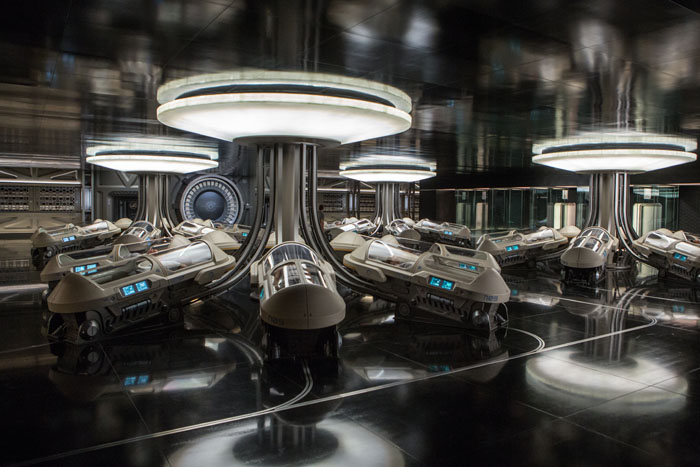
BRANDON: Right. Early on when the beginning was more expanded, there was a feeling that he was creepy, and it was creepy thing to do. We spent a lot of time making the audience understand that it wasn’t an act of shopping for a mate. It’s tricky.
HULLFISH: Like you said, if it had been an independent movie you could have done an entire movie that ends with him either waking her up or not waking her up.
BRANDON: Right. Or you could have done an entire movie about forgiveness or not, but not with Jennifer Lawrence and Chris Pratt. You know what I mean? What I love about Passengers and what Morten (director, Morten Tyldum) tried to do and what (writer) Jon Spaihts tried to do–I think the movie is incredibly provocative and entertaining. What they tried to do was make a big film that people would go see, and have fun, feel emotion, wasn’t a sequel, wasn’t a superhero movie, wasn’t out in the extraordinary realm of freaking fantasy crazy time. It’s going to make you ask questions. It’s going to make you think. That was my hope and dream for Passengers.

HULLFISH: You have to know what kind of a film you’re driving, right? Are you driving a Porsche or are you driving an old 1970s Cadillac? And with this movie you have two, beautiful lead actors, you have a ship that is gorgeous inside and out. Did you feel like your editing also had to have a kind of slickness to it whereas with other movies they kind of try and show the rough edges.
BRANDON: A lot of that is in the directing. That’s how Morten directed it. I wouldn’t go against how he directed it. Would I call the editing slick? I tried to have fun with it. I tried to show them having fun, I tried to show them when they were sad. It’s slick in that I hope you don’t really notice the editing, and it’s rough in that I tried to put ideas of happiness and sadness and loneliness and bravery together by putting them right next to each other.
HULLFISH: And then there’s also that thought of the tone of the movie, knowing that you’re going to have this dark section where she realizes that he woke her up, and he’s going to be guilt-ridden about it and she’s going to be pissed. Because you know you’ll have that darkness you also have to have the lightness before it because otherwise the whole movie is depressing.
BRANDON: Absolutely, right. So the movie kept changing tone, and I think that’s the fun part of the movie. It keeps you engaged, because even though they’re in the same place, new things keep changing the way they feel. And isn’t that a lot like life?
HULLFISH: Absolutely. I’m always fascinated by this idea, especially when you’ve got a character that has to go through a range, like Jennifer Lawrence’s character has to go through this process of coming to grips with what Chris Pratt’s character did, falling back in love with him, forgiveness, whatever, and to be able to modulate that performance over an hour, you’ve got to really create a performance that makes a gradual swing. She can’t just go from being mad to being in love with him again.
BRANDON: No. That was tricky. That was really tricky and we talked a lot about that. A lot of it is in her performance. It’s really tethered to the whole last forty-five minutes of the film. There’s not a scene where she just forgives him, but it’s kind of sprinkled through there and her slow realization that, yeah he woke her up, but he was woken up as well and now it’s even worse because of the added thing that the whole ship would have been killed anyway if he hadn’t woken up.
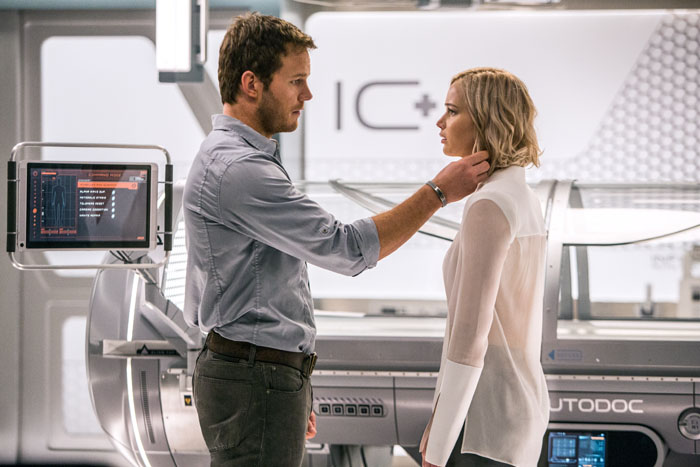
HULLFISH: But for the actors of course, the actors don’t have a lot of context. Obviously they’re professionals and so the director helps them and they prepare so that they know as they do a scene, “Hey, I need to be at this point in my thought process or emotional life.” But the only person that really has that context is you, because you’re watching it in a continuous storyline. Is there a variety of temperatures of a performance that you’re able to mold?
BRANDON: Yes. For sure. Especially with Jennifer and Chris because they did a lot. They explored a lot. They went to a lot of different places. She’s amazing. Her whole physicality changes when she gets sad or when she’s happy or when she’s pensive. She physically kind of transforms, which I found fascinating. And Chris surprised me because he’s got such a broad spectrum. I mean he can go really, really dark. I don’t think a lot of people let him do the dark thing because he’s so funny and he’s such a sort of every guy and people love him to be the nice guy, but he can go pretty dark.
HULLFISH: I saw a behind-the-scenes video of Chris driving around in a go-cart dune-buggy kind of thing. But that wasn’t in the movie.
BRANDON: Yeah. That was a scene I cut out.
HULLFISH: So talk to me about that decision. Here’s a fun, exciting scene that gives us some action, but you say, “You know what? It’s just not working for me.”
BRANDON: That’s basically what it was. Chris Pratt’s character was really frustrated with himself. It was after the lie came out and after she rejected him, and he basically wanted to hurt himself. It didn’t go anywhere or service the film. You understood that already when he makes the phone call, when he says, “I fell in love with you, I don’t know what happened, but if I could undo it I would undo it,” and then she beats the shit out of him. It kind of took the film in a weird place. It just had a totally different tone to it and it seemed in a weird way, childish. It didn’t feel like it belonged in the film no matter how I cut it and I think the director felt the same way. It wasn’t worthy of being in the film, really.
HULLFISH: Let’s talk a little bit about that fact that there’s the film you write, the film you shoot, and the film you edit, and they’re three different things. How is it that this film obviously had huge input from the studio, had multiple really smart people on the development side and that scene is in there in the script, but later on you figure out that you don’t need that scene, yet the screenwriter, and the studio at some point, thought you needed that scene?
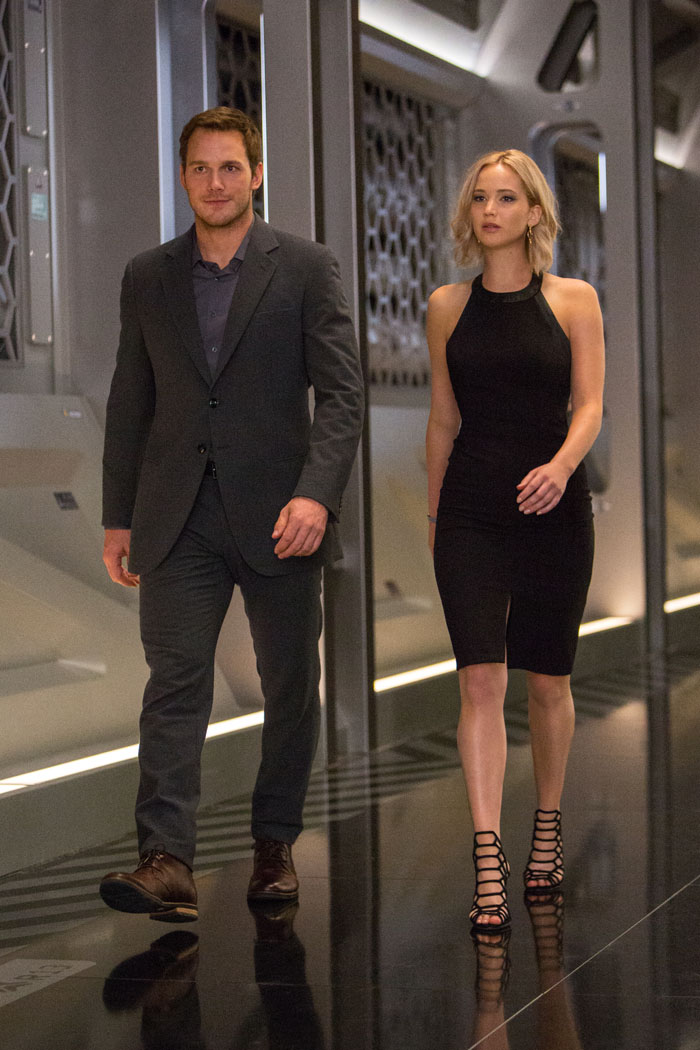
BRANDON: You don’t just throw it out.You kind of work it, work it, work it, and I think you have to go with your gut at some point. And you go to the studio and they see it and you make an argument and they make one. In editing, it is the final rewrite. It’s a balance. If a scene hurts a character’s progression, then it isn’t worthy of being in the film. Or if it’s just there as a spectacle, you’ve got to weigh out: is it worth having a spectacle at this point or not? You can feel it when you’re watching the film. Do I want to be watching this right now? The studio was very involved.
HULLFISH: But that’s one of those things that’s fascinating: here’s a scene finally with some action–I mean there’s other action in the movie for sure, there’s space walks and explosions and all kinds of stuff–but you have to in the end the story is more important than some cool visuals of a dune buggy.
BRANDON: Absolutely. There are hundreds of thousands of cool visuals that we’ve seen in film. It’s not new. I mean when you saw a film like Gravity it was kind of ground-breaking and that put the bar up a little higher and each time it goes a little higher, but part of the cool factor of cool visuals is that they have to work with the story.
HULLFISH: Right. Exactly. Tell me a little about temp music. Do you remember some of the stuff that you temped with?
BRANDON: The temp music was really hard. Music was such a big part of this film and John Finklea who was my music editor did a great job. He set down some really interesting choices. Some things were from The Martian. Tommy Newman was our composer. Some of it was his stuff. But it was hard to get a cohesive score because it was a lot of music in the film and it stood out because essentially is was another character in the film because there’s not a lot of other people. It was tricky, and I didn’t have a lot of time to do music, so I really depended on just listening to things and saying yes or no and having them recut a million times to fit what I was seeing. And we use temp music a lot to evoke emotion because one guy in space–what else do you have? You just have music and a guy in space. The visual effects, Chris Pratt, and music. And that’s it.
HULLFISH: Since you had Thomas Newman writing the score, some people would consider only temping with Thomas Newman.
BRANDON: He doesn’t like that. He doesn’t like you to use his stuff, and we had put a lot of stuff in before we even got Thomas Newman. Originally the composer was supposed to be Alexandre Desplat, and then he dropped out early on because he was doing Rogue One, which turns out he didn’t do, but we knew there wasn’t enough time, so we had to find a new composer.
HULLFISH: Tell me about the music choice of that Elvis song for that montage.
BRANDON: I really needed a song just to cut the montage at first. It wasn’t necessarily going to have a song in there, but those images weren’t cut as a montage, so I needed a sort of rhythm-based thing to figure out how to do it because it was really tricky cutting that area down and making it land emotionally and musically. Maarten Hofmeijer, our other music editor found that music. What spoke to me about was that Elvis has this very kind of soulful voice, and very masculine voice. I just felt like it worked with Jim’s character, and I thought the lyrics were interesting because it’s all about conversation and being with people. And then it worked where we could ring it out. It was a simple song that could bring out into the background and blend in.
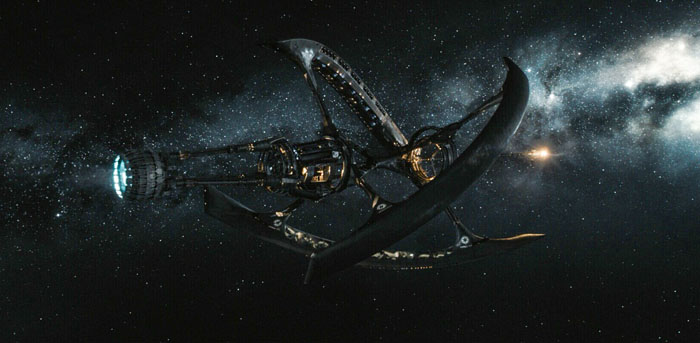 HULLFISH: And like you said, there are multiple reasons why it worked, just lyrically and tone-wise all that. And lots of other people have told me about editing montages that you even pick a piece of music that you know you’re going to replace just because you know that it’s the right rhythm and the right attitude that will help you get through it, and then later on someone can replace it with something else and it will still work.
HULLFISH: And like you said, there are multiple reasons why it worked, just lyrically and tone-wise all that. And lots of other people have told me about editing montages that you even pick a piece of music that you know you’re going to replace just because you know that it’s the right rhythm and the right attitude that will help you get through it, and then later on someone can replace it with something else and it will still work.
BRANDON: Right. I thought it actually made the film interesting on several levels and at that moment, you know, his enthusiasm to make it work and how it’s kind of wound down to the loneliness, the real deal. I stopped looking for something better because I thought it was really working well.
HULLFISH: That actually brings us to another interesting point which is they always say great art is knowing when to stop.
BRANDON: That’s true. For me, I stop when the film gets released. And even after the film gets released I’m like should I have, could I have? That’s just kind of a result of how invested I am in something. But yeah, there is a moment where you have to just go, “I think we’re there. For now.”
HULLFISH: Of course the flip side of the great art ending quote is the classic: No film is ever finished, it’s just abandoned.
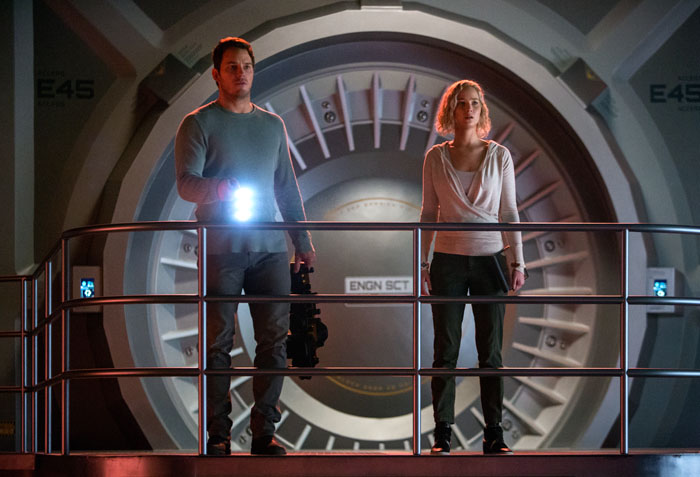
BRANDON: I think that’s true. But I do think you can over-cut a film. And I think you can go too far. I think it’s a good thing that there’s a limit on it, because sometimes you start to chip away at the things that you’re just getting so used to. There is a moment where it’s balanced, and then you can go over the edge.
HULLFISH: That’s definitely true. You get to the point where it’s just information, where you don’t have art anymore.
BRANDON: Right. And you’re not letting things breathe and you’re not letting people feel things that they should be feeling or see things that are interesting enough. It’s a hard one. It’s hard to know when to stop, and when you’re going too fast, and when you’re going too slow. You don’t want to lose an audience, and you can lose them in both those ways.
HULLFISH: Right. Exactly. Either they don’t have enough information to be invested or they’re bored and can predict where the movie is going.
BRANDON: Right. And they drift away. It’s very difficult. It’s very difficult in certain movies to know when that is.

HULLFISH: Somebody as talented and experienced of an editor as you, you’re using your own sense of that as you’re cutting, but then how much of that also is–I’m sure they audience tested this–and so how much of that is you sitting in a room with an audience and going, “Ugh, I think I’m losing them here.”
BRANDON: A lot of it sitting in an audience and feeling their reaction and listening to what they have to say. I always say, “It’s not what people tell me.” I’m not looking for solutions from anyone to tell me how to make it better, I’m just looking for where they have problems. And a lot of times for me, and it’s a thing I constantly remind myself, if they’re not with it at a certain moment, it’s something that happened twenty minutes before in the film, not the thing that’s happening right then and there, but it’s something they missed or something didn’t land for them or they didn’t believe it or didn’t go with it and it kind of threw them off and twenty minutes later they’re like, “I don’t like this.” A lot of times when an ending is not working, for instance in a film, it’s something twenty minutes earlier.
HULLFISH: That happened to me on a film where we had a character that at a certain point people said they didn’t like in the scene, and we thought that scene was pretty good, and we changed one shot in a scene that happened the previous time she was on screen, and that took care of all the notes.

BRANDON: Yes. I think that’s a big thing to learn. That’s a big lesson to learn.
HULLFISH: And I’ve heard that from multiple other people that notes are great in identifying the problem, but they’re rarely the solution.
BRANDON: Yeah. I’ll work with the director to get the solution. I just need to know where the problems are. That’s very true.
HULLFISH: How much does all the VFX stuff that you had to deal with affect timing and pacing and are you working with pre-vis and post-vis where it’s pretty dialed-in, or do you find that when you get a final effect, you go, “Man, I want to sit on this beautiful shot of this spaceship spinning in space longer than I had when it was just some ugly pre-vis?
BRANDON: In a film like this it’s huge. I’ll time it out with pre-vis–I use pre-vis and post-vis a lot. The visual effect houses have to use it because they can’t just do it from scratch. You have to have a pre-vis or post-vis to even get the timing and figure out the camera work. It evolves as they come in in different stages–they don’t always come in as finals–and each time I’ll cut it in and figure out. Sometimes the timing is dictated by me. A lot of times it is, and then sometimes they’ll show me a shot and I’ll redo the timing to accommodate the shot because it’s great or it works or it does something I didn’t expect it to do. So all of the above.
HULLFISH: At some point it’s got to be locked because they’re spending a lot of money on renders or whatever.
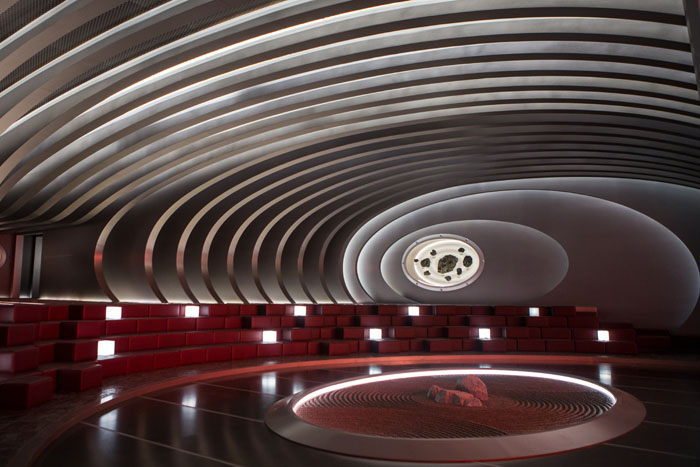
BRANDON: Well that’s the thing. They’re spending a lot of money. To save money, they push the finals toward the end so you’ve got to pretty much know what you want before. You’re not going to have a lot of choices, because things get pushed back in the schedule and you can’t keep sending things back for redo. You got to be pretty sure upfront what you want, and visualize what you want. Communication is really important: to be able to have a visual effects supervisor that is on the same page as you and that you work it out with them and you know they understand the language you’re talking, because you’re just not going to get a lot of shots at it. It’s just too expensive.
HULLFISH: And all of the handoffs I’m assuming are done not really by you–obviously you’re supervising–but the assistants are dealing with shot versioning and all that.
BRANDON: They hand it all off. It would be too much for me to do the technical stuff. I understand the technical stuff, but I don’t really don’t want any part of it at the moment. I have too much on my plate.
HULLFISH: What did you learn from this movie? Was there anything specific that you were like, “Now that is a new piece of information for me?”
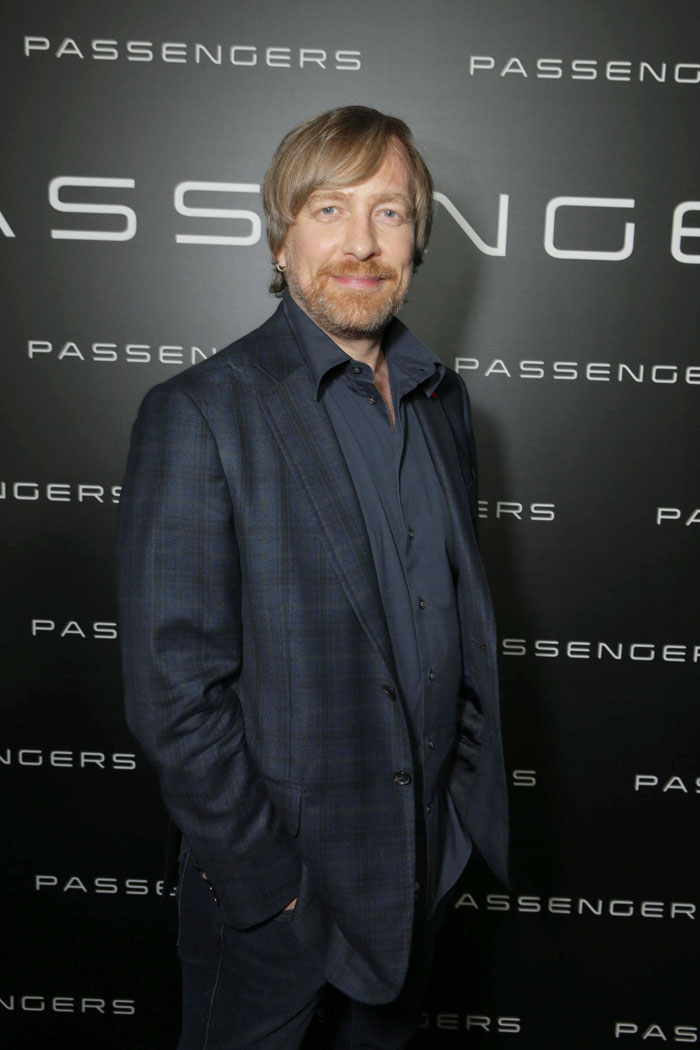
BRANDON: Just to remind myself of things that work and don’t work and solving problems. Listening to an audience, but not getting lost in things that they say. I learn something new every film I do. It’s always a new experience. I like to remind myself to always be open-minded to the director and feel them out and try to understand how to bring the film a better place than it started out being.
HULLFISH: You’ve worked a lot obviously with J.J. Abrams. Was this a new director for you and how was that kind of feeling out period with him?
BRANDON: With Morten, he’s a really open guy and was open to suggestions. It was pretty easy. I’ve worked with other directors. In between J.J. films I do other films, so I’ve worked with a lot of other directors. I like the getting to know you process. I think it’s really interesting, so that was something I was really looking forward to and I really enjoyed working with Morten. It was very different. A different kind of vibe, a different setup, but it was very fulfilling. He really put his trust in me, which I’m glad that I could evoke that in a director, and that’s important. It helped me hone in on my people skills.
HULLFISH: Trust is a huge issue in the edit suite.
BRANDON: Yes. Very big. Obviously there are other directors that I probably wouldn’t want to work with because they don’t work on that level. And that’s okay. I’m good with that.
HULLFISH: You’ve done so much work with Mary Jo Markey.
BRANDON: You know I’ve worked for years without Mary Jo before I did Mission. I cut many films before and it was really J.J. who asked us both to do it together. And it’s great and its worked, but for other directors and my relationship with other directors it’s probably better one-on-one. It’s nice to have both. I love working with Mary Jo. She’s genius and we have a great back-and-forth. And on J.J. films it’s probably a necessary thing because he shoots a massive amount of film and he likes input from everywhere. Other directors don’t work so much like that. I enjoy both. I really did enjoy cutting this on my own though and I probably will do more.
HULLFISH: But when you’re cutting with somebody else, it’s kind of nice to have somebody else who understands you and isn’t the director that you can bounce ideas off of.
BRANDON: Oh yes, sure. I have my first assistant. And the whole crew I bounce ideas off of and they come to me. I have a very open policy in the cutting room. Everyone can come in and give me their opinion. And a lot of times I’ll go into them and ask their opinion. It’s not like I don’t have that when I don’t have a Mary Jo. I have the best of both.
HULLFISH: That’s cool. That’s very nice of you to do. How much cutting do you let your assistants or first assistants do? Not that they’re the final say.
BRANDON: If I’m really over-run I let them do, or I ask them to do more and if I’m caught up I’ll ask them their opinion or have a go at a scene I’ve already cut and give me their version and take the best of both. I’m pretty good about it. I like them to understand the editorial process because I think it helps everyone to engage in the film and not just being doing a tech job, but it helps them really own it. They’ve got something invested now and I think that’s a really important thing, so it helps me a lot and also the better an editor my assistant is, the better for me, so I’m happy to teach them everything I know.
HULLFISH: Until they leave.
BRANDON: And then they leave, but, you know, that’s as it should be. That’s okay. Then they’ll say whoever else is on the crew and that person will become my first after that.
HULLFISH: Did you learn anything on this film by making a mistake? Or can you think of another film where you were like “I did this, it was wrong, and I’m changing it and I learned something from that?”
BRANDON: I think that happens all the time, you know, I’ll cut a scene and it’ll be too long or I’ll go somewhere else on it and I’ll be like oh that was a mistake and hopefully… I can’t think of anything specifically on this film, but I do think that, I mean even like the first twenty minutes of this film when it used to be a half an hour and I really was fighting for it to be half an hour and the studio kept saying “No, he’s got to wake her up sooner, we got to get her in the film” I backed down because I realized they were right, she did have to get into the film early, she did have to shift earlier and I was willing to go longer and they were adamant about it and they had to convince me, but I got there.
HULLFISH: Do you try at all to learn something new about either the way that you organize a film or technically about Media Composer in ways that you haven’t done before?
BRANDON: Sure. On Star Wars I learned split-screens really well. I perfected my split screen and my little speed ups. I like to learn something new, I like to advance in my technical abilities.
HULLFISH: So the split-screens you’re talking about are scenes where you might have a performance on one side of the frame that you like, but you need to alter the performance on the other side of the frame?
BRANDON: Right, right, I want them to do something else on the other side.
HULLFISH: But you still want to be on the wide shot?
BRANDON: Correct.
HULLFISH: Maryann, thank you so much for your time.
BRANDON: My pleasure.
To read more interviews in the Art of the Cut series, check out THIS LINK and follow me on Twitter @stevehullfish
Thanks to Jada Sacco at Moviola for transcribing.
Also, the Art of the Cut interviews have been curated into a new book that is now available for pre-order. 50 of the best film and TV editors in a virtual roundtable discussion on topics including storytelling, pacing, structure, documentary, collaboration and approach to a scene.

Filmtools
Filmmakers go-to destination for pre-production, production & post production equipment!
Shop Now